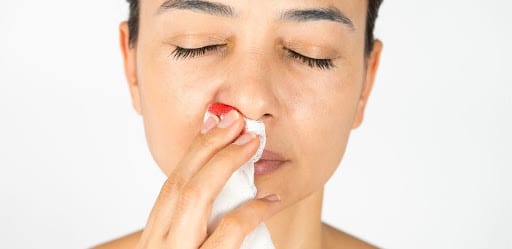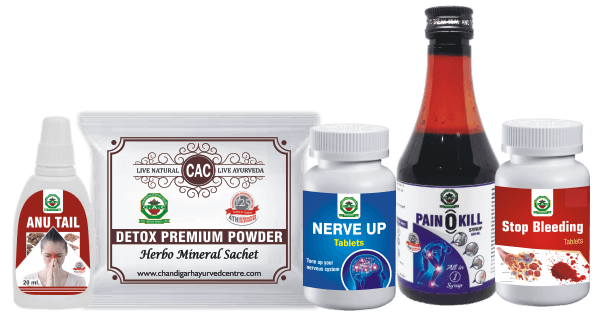
NOSEBLEEDING OR EPISTAXIS AND ITS AYURVEDIC MANAGEMENT
- January 16, 2023
- Posted by Dr. Vaidya Karanvir Singh
- 0 Comment(s)
Epistaxis or nosebleed can happen easily due to location of nose and close to surface location of blood vessels in lining of nose. It is very common and at least 60% of people have at least one nosebleed episode in their lifetime.
Epistaxis word is derived from Greek word epistazein that means bleed from the nose. It is more common in children aged between 2-10 years and older peoples aged between 50-80 years. Bleeding in epistaxis can range from a trickle to strong flow and the outcome can range between minor irritation to life threatening hemorrhage.
Table of Contents
WHAT ARE DIFFERENT KINDS OF EPISTAXIS(NOSE BLEEDING) ?
Epistaxis can be differentiated into two kinds due to site of the bleeding . Those types are :
- Anterior Epistaxis : It originates from anterior part of nose and mostly it originate from vascular network found on nasal septum called as Kiesselbach plexus as arteries present their are easily traumatized. This most common type of Nosebleed mostly occurring in children. It is generally not serious and can be treated at home.
- Posterior Epistaxis : It is referred as bleeding from posterior or superior nasal cavity and commonly it originates from vascular network in lateral wall of nasal cavity called as Woodruff plexus . It generally involve both nostrils and in this type of epistaxis blood can also flow backwards and uncomfortably can get swallowed or coughed up. It is more common in adults and individual needs medical attention immediately for this type of epistaxis.
WHO IS MORE PRONE TO GET EPISTAXIS(NOSE BLEEDING)?
It is a common condition and anyone can get it but some individuals are more likely to have nosebleed . They are:
- Children: Dry air, sticking fingers and objects into nose and allergies make children between age of 2-10 more prone to epistaxis.
- Adults: In individuals aging between 45-65 blood may take longer to clot and they are also more likely to be on blood thinning drugs, have high blood pressure, atherosclerosis or bleeding disorder which make them more prone to epistaxis.
- Pregnant women : Due to pregnancy blood vessels of nose expands which put extra pressure on delicate blood vessels present in lining of nose. This make pregnant women more prone to epistaxis.
WHAT ARE THE CAUSES OF EPISTAXIS (NOSE BLEEDING)?
Most common cause of nosebleed is :
- Dry air -Dry air dries out nasal membrane making it crusty or cracked and more susceptible to bleeding when rubbed or picked
- Nose picking
Other common causes of Epistaxis are :
- Blowing nose with force
- Cold and Sinusitis episodes
- Inserting objects into nose
- Blood thinning drugs like NSAIDs, warfarin, aspirin etc.
- Allergic and Non-allergic rhinitis.
- Cocaine and other drugs which are inhaled through nose
- Chemical irritants like chemical fumes, cleaning supplies, other strong odors etc
- Deviated septum
- Injury to nose or face
- High altitude as the air is thinner and drier
- Frequent use of nasal sprays and medications can dry out nasal membranes
Less common causes of Epistaxis are :
- High Blood Pressure
- Alcohol use
- Nasal polyps
- Bleeding disorders like leukemia, hemophilia etc
- Atherosclerosis
- Nasal tumors
- Immune thrombocytopenia
- Facial and nasal surgery
- Hereditary hemorrhagic telangiectasia
SELF CARE STEPS TO STOP OCCASIONAL EPISTAXIS (NOSE BLEEDING):
- Sit upright and Lean forward : Sitting forward and remaining upright helps to avoid swallowing of blood which can irritate stomach.
- Calmly blow nose to clear out any clotted blood in nose.
- Pinch nose : Pinch both nostrils shut with thumb and index finger and breath through mouth for 10-15 minutes. This will put pressure on bleeding point on nasal septum and can stop the bleeding
- Repeat these steps for up to a total of 15 minutes if bleeding doesn’t stop.
PREVENTIVE TIPS FOR EPISTAXIS(NOSE BLEEDING) :
- Trimming child’s fingernails
- Keeping lining of nose moist with light coating of petroleum jelly , ointment or saline nasal spray.
- Using a humidifier to counter the affect of dry air.
AYURVEDIC APPROACH :
In ayurveda it can be correlated to Urdhvagata raktapitta. Nidan sevan like improper diet and stressfull lifestyle leads to vitiation of Pitta dosha. The aggravated pitta pollutes the rakta vaha channels and increase the blood volume in body due to hot and liquid potency of pitta. The increased blood moves in an upward direction and starts to flow out from the nasal passages.
HERBS :
- Kutaja
- Padma
- Vasa
- Lodhra
- Shatavari
PANCHKARMA :
- Nasya Karma
- Shiro Dhara
CHANDIGARH AYURVEDIC CENTRE MEDICATION FOR THE TREATMENT OF EPISTAXIS(NOSE BLEEDING)
1. Anu Tailam:
Anu tailam is herbal and ayurvedic oil used for the nasal instillation that treats various diseases. It is administrated through the nasal passage to lubricate, protect, and calm the mind. This herbal oil is prepared from ingredients like – Sesame oil, Bael tree root, Solanum root, Cinnamon stem bark, Cardamom fruit, Desmodium root, etc. It mainly balances the Kapha dosha and is beneficial in diseases of head, brain, face, nose, and eyes. Its use is generally recommended in chronic headache, the problem of migraine, sinusitis, improves the voice, and vocal cords.
Recommended Dosage– Put 2-3 drops of Anu tailam in each nostril twice a day.
2. Detox Premium Powder:
Detox premium powder is prepared from ingredients such as Shankh bhasma, Sutshekhar ras, Parwal pishti, Shukta, Giloy, Kamdudha ras, Shwet parpati that gives calming effect on the stomach. The ingredients in this powder have anti-inflammatory, antioxidant, and antacid properties. It mainly helps in lowering the pitta dosha of the body and maintains proper digestion of the body.
Recommended Dosage: Take one sachet twice daily with normal water.
3. Pain -O-Kill Syrup:
This herbal oil is prepared from ingredients like Hadjod stem, Ashwagandha roots, Shalaki Gum, Suranjan sweet Gum, Punarnava Root, Methi seeds, Nirgundi leaves, Garlic Bulb, etc. It is very beneficial in reducing stiffness, inflammation, and pain. This syrup helps to rejuvenate the body tissues and improve the muscle tone. Regular use of this syrup is beneficial in the epistaxis condition.
Recommended Dosage– Take 2 teaspoonfuls twice a day.
4. Nerve Up Tablet:
These are classical herbal tablets that balances the vata dosha in the body & provide good results to epistaxis patients. The ingredients such as abhrak bhasma, jahar mohra pishti, giloy, jahar mohra pishti, etc are used for the preparation of these tablets.
Recommended Dosage: Take 1 tablet twice a day with normal water.
5. Stop Bleeding Tablet:
Stop bleeding tablet is a pure herbal formulation that works as an anticoagulant. It helps to stop or reduce heavy bleeding and thus reduce the excessive unwanted bleeding. These tablets have anti-inflammatory, Analgesic, anticoagulant properties. It also pacifies pitta doshas and helps in detoxification of rakta dhatu (blood tissue). The Ingredients present in these tablets are Nagkesar, Laksha , Moch ras, Swarn gairic, Kehrwa pisthri. These tablets Helps to stop bleeding from nose and mouth, used in thrombocytopenic purpura, bleeding disorder, Heavy menstrual bleeding, Ulcerative colitis, Peptic ulcers, Wounds& cuts.
Recommended Dosage: Take 1 tablet twice daily with normal water.

Dr. Vaidya Karanvir Singh is the younger Vaidya in Chandigarh Ayurved & Panchakarma Centre. He is the fourth generation in his family who is practicing as a general consultant in Ayurved & Panchakarma treatment at Chandigarh. In his practice, he had treated more than 1 Lakh Plus patients worldwide.


